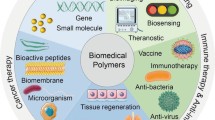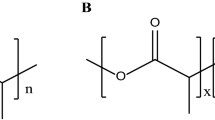Abstract
Surface modification with poly(2-methacryloyloxyethyl phosphorylcholine) (PMPC) is an effective method for improving hemocompatibility. Peptide GREDVY immobilized on Ti is of great benefit to endothelialization. Micropattern of PMPC and GREDVY can regulate cells distribution, behaviors, and nitric oxide (NO) release. Copper can be used as catalytic to release NO from a donor in vitro, which can inhibit platelets adhesion, activation, and aggregation. The Ti-PDA(Cu)-M/R(P) micropattern was fabricated with PMMPC-HD {PMMPC [monomer contain MPC and methacrylic acid (MA)] was cross-linked with hexamethylene diamine} and peptide Gly-Arg-Glu-Asp-Val-Tyr (GREDVY) using PDMS stamp, and it was characterized by SEM, FTIR, and XPS. The results demonstrated that the PMPC and peptide GREDVY were immobilized onto polydopamine successfully. Simultaneously, the copper existed in polydopamine was confirmed by XPS. The rate of NO release in vitro catalyzed by copper ions was 1.5–5.3 × 10−10 mol/(cm2 min). It will be beneficial to inhibiting platelets adhesion and proliferation of ECs.








Similar content being viewed by others
References
D.F. Williams: On the mechanisms of biocompatibility. Biomaterials 29, 2941 (2008).
G. Li, P. Yang, W. Qin, M.F. Maitz, S. Zhou, and N. Huang: The effect of coimmobilizing heparin and fibronectin on titanium on hemocompatibility and endothelialization. Biomaterials 32, 4691 (2011).
D. Tousoulis, A.M. Kampoli, C. Tentolouris, N. Papageorgiou, and C. Stefanadis: The role of nitric oxide on endothelial function. Curr. Vasc. Pharmacol. 10, 4 (2012).
J. Lei, Y. Vodovotz, E. Tzeng, and T.R. Billiar: Nitric oxide, a protective molecule in the cardiovascular system. Nitric Oxide 35, 175 (2013).
N. Naghavi, M.A. De, O.S. Alavijeh, B.G. Cousins, and A.M. Seifalian: Nitric oxide donors for cardiovascular implant applications. Small 9, 22 (2013).
A. de Mel, F. Murad, and A.M. Seifalian: Nitric oxide: A guardian for vascular grafts? Chem. Rev. 111, 5742 (2011).
L.J. Taite, P. Yang, H.W. Jun, and J.L. West: Nitric oxide-releasing polyurethane-PEG copolymer containing the YIGSR peptide promotes endothelialization with decreased platelet adhesion. J. Biomed. Mater. Res., Part B 84, 108 (2008).
X. Li, H. Qiu, P. Gao, Y. Yang, Z. Yang, and N. Huang: Synergetic coordination and catecholamine chemistry for catalytic generation of nitric oxide on vascular stents. NPG Asia Mater. 10, 482 (2018).
S. Hwang, W. Cha, and M.E. Meyerhoff: Polymethacrylates with a covalently linked CuII–cyclen complex for the in situ generation of nitric oxide from nitrosothiols in blood. Angew. Chem., Int. Ed. 118, 2811 (2006).
Z. Yang, Y. Yang, K. Xiong, X. Li, P. Qi, Q. Tu, F. Jing, Y. Weng, J. Wang, and N. Huang: Nitric oxide producing coating mimicking endothelium function for multifunctional vascular stents. Biomaterials 63, 80 (2015).
P. Zorlutuna, N. Annabi, G. Camci-Unal, M. Nikkhah, J.M. Cha, J.W. Nichol, A. Manbachi, H. Bae, S. Chen, and A. Khademhosseini: Microfabricated biomaterials for engineering 3D tissues. Adv. Mater. 24, 1782 (2012).
F. Zhang, G. Li, P. Yang, W. Qin, C. Li, and N. Huang: Fabrication of biomolecule-PEG micropattern on titanium surface and its effects on platelet adhesion. Colloids Surf., B 102, 457 (2013).
J. Chen, J. Ge, B. Guo, K. Gao, and P.X. Ma: Nanofibrous polylactide composite scaffolds with electroactivity and sustained release capacity for tissue engineering. J. Mater. Chem. B 4, 2477 (2016).
L. Wang, Y. Wu, B. Guo, and P.X. Ma: Nanofiber yarn/hydrogel core–shell scaffolds mimicking native skeletal muscle tissue for guiding 3D myoblast alignment, elongation, and differentiation. ACS Nano 9, 9167 (2015).
Y. Wu, L. Wang, B. Guo, and P.X. Ma: Interwoven aligned conductive nanofiber yarn/hydrogel composite scaffolds for engineered 3D cardiac anisotropy. ACS Nano 11, 5646 (2017).
Y. Wu, L. Wang, T. Hu, P.X. Ma, and B. Guo: Conductive micropatterned polyurethane films as tissue engineering scaffolds for Schwann cells and PC12 cells. J. Colloid Interface Sci. 518, 252 (2018).
M. Nikkhah, N. Eshak, P. Zorlutuna, N. Annabi, M. Castello, K. Kim, A. Dolatshahi-Pirouz, F. Edalat, H. Bae, and Y. Yang: Directed endothelial cell morphogenesis in micropatterned gelatin methacrylate hydrogels. Biomaterials 33, 9009 (2012).
M. Versaevel, T. Grevesse, and S. Gabriele: Spatial coordination between cell and nuclear shape within micropatterned endothelial cells. Nat. Commun. 3, 671 (2012).
Y. Liu, K. Ai, and L. Lu: Polydopamine and its derivative materials: Synthesis and promising applications in energy, environmental, and biomedical fields. Chem. Rev. 114, 5057 (2014).
H. Lee, S.M. Dellatore, W.M. Miller, and P.B. Messersmith: Mussel-inspired surface chemistry for multifunctional coatings. Science 318, 426 (2007).
H. Ren, J. Wu, C. Xi, N. Lehnert, T. Major, R.H. Bartlett, and M.E. Meyerhoff: Electrochemically modulated nitric oxide (NO) releasing biomedical devices via copper(II)-Tri(2-pyridylmethyl)amine mediated reduction of nitrite. ACS Appl. Mater. Interfaces 6, 3779 (2014).
J. Pant, M.J. Goudie, S.P. Hopkins, E.J. Brisbois, and H. Handa: Tunable nitric oxide release from S-nitroso-N-acetylpenicillamine via catalytic copper nanoparticles for biomedical applications. ACS Appl. Mater. Interfaces 9, 15254 (2017).
J.L. Harding: Composite materials with embedded metal organic framework catalysts for nitric oxide release from bioavailable S-nitrosothiols. J. Mater. Chem. B 2, 2530 (2014).
V. Wonoputri, C. Gunawan, S. Liu, N. Barraud, L.H. Yee, M. Lim, and R. Amal: Copper complex in poly(vinyl chloride) as a nitric oxide-generating catalyst for the control of nitrifying bacterial biofilms. ACS Appl. Mater. Interfaces 7, 22148 (2015).
Z. Jia, H. Li, Y. Zhao, L. Frazer, B. Qian, E. Borguet, F. Ren, and D.A. Dikin: Electrical and mechanical properties of poly(dopamine)-modified copper/reduced graphene oxide composites. J. Mater. Sci. 52, 11620 (2017).
H. Lee, J. Rho, and P.B. Messersmith: Facile conjugation of biomolecules onto surfaces via mussel adhesive protein inspired coatings. Adv. Mater. 21, 431 (2009).
Z.L. Yang, S. Zhong, Y. Yang, M.F. Maitz, X. Li, Q.F. Tu, P. Qi, H. Zhang, H. Qiu, and J. Wang: Polydopamine-mediated long-term elution of the direct thrombin inhibitor bivalirudin from TiO2 nanotubes for improved vascular biocompatibility. J. Mater. Chem. B 2, 6767 (2014).
Y. Yang, X. Li, H. Qiu, P. Li, P. Qi, M.F. Maitz, T. You, R. Shen, Z. Yang, W. Tian, and N. Huang: Polydopamine modified TiO2 nanotube arrays for long-term controlled elution of bivalirudin and improved hemocompatibility. ACS Appl. Mater. Interfaces 10, 7649 (2018).
J. Park, T.F. Brust, H.J. Lee, S.C. Lee, V.J. Watts, and Y. Yeo: Polydopamine-based simple and versatile surface modification of polymeric nano drug carriers. ACS Nano 8, 3347 (2014).
W. Ma, L. Liu, H. Chen, Y. Zhao, P. Yang, and N. Huang: Micropatterned immobilization of membrane-mimicking polymer and peptides for regulation of cell behaviors in vitro. RSC Adv. 8, 20836 (2018).
Y. Wei, Y. Ji, L.L. Xiao, Q.K. Lin, J.P. Xu, K.F. Ren, and J. Ji: Surface engineering of cardiovascular stent with endothelial cell selectivity for in vivo re-endothelialisation. Biomaterials 34, 2588 (2013).
Y. Liu, T.T. Yang Tan, S. Yuan, and C. Choong: Multifunctional P(PEGMA)–REDV conjugated titanium surfaces for improved endothelial cell selectivity and hemocompatibility. J. Mater. Chem. B 1, 157 (2013).
S.P. Massia and J.A. Hubbell: Vascular endothelial cell adhesion and spreading promoted by the peptide REDV of the IIICS region of plasma fibronectin is mediated by integrin alpha 4 beta 1. J. Biol. Chem. 267, 14019 (1992).
M.S. Hahn, L.J. Taite, J.J. Moon, M.C. Rowland, K.A. Ruffino, and J.L. West: Photolithographic patterning of polyethylene glycol hydrogels. Biomaterials 27, 2519 (2006).
J.A. Hubbell, S.P. Massia, N.P. Desai, and P.D. Drumheller: Endothelial cell-selective materials for tissue engineering in the vascular graft via a new receptor. Nat. Biotechnol. 9, 568 (1991).
L. Chen, J. Li, S. Wang, S. Zhu, C. Zhu, B. Zheng, G. Yang, and S. Guan: Surface modification of the biodegradable cardiovascular stent material Mg–Zn–Y–Nd alloy via conjugating REDV peptide for better endothelialization. J. Mater. Res. 33, 4123 (2018).
J. Wu, W. Lin, Z. Wang, S. Chen, and Y. Chang: Investigation of the hydration of nonfouling material poly(sulfobetaine methacrylate) by low-field nuclear magnetic resonance. Langmuir 28, 7436 (2012).
Q. Huang, Y. Yang, R. Hu, C. Lin, L. Sun, and E.A. Vogler: Reduced platelet adhesion and improved corrosion resistance of superhydrophobic TiO2-nanotube-coated 316L stainless steel. Colloids Surf., B 125, 134 (2015).
X. Liu, L. Yuan, D. Li, Z. Tang, Y. Wang, G. Chen, H. Chen, and J.L. Brash: Blood compatible materials: State of the art. J. Mater. Chem. B 2, 5718 (2014).
W. Ma, P. Yang, J. Li, S. Li, P. Li, Y. Zhao, and N. Huang: Immobilization of poly(MPC) brushes onto titanium surface by combining dopamine self-polymerization and ATRP: Preparation, characterization and evaluation of hemocompatibility in vitro. Appl. Surf. Sci. 349, 445 (2015).
H. Chen, X. Li, Y. Zhao, J. Li, J. Chen, P. Yang, M.F. Maitz, and N. Huang: Construction of a multifunctional coating consisting of phospholipids and endothelial progenitor cell-specific peptides on titanium substrates. Appl. Surf. Sci. 347, 169 (2015).
D.E.J. Anderson and M.T. Hinds: Endothelial cell micropatterning: Methods, effects, and applications. Ann. Biomed. Eng. 39, 2329 (2011).
W. Cha and M.E. Meyerhoff: Catalytic generation of nitric oxide from S-nitrosothiols using immobilized organoselenium species. Biomaterials 28, 19 (2007).
Z. Yang, X. Lei, J. Wang, R. Luo, T. He, H. Sun, and N. Huang: A novel technique toward bipolar films containing alternating nano-layers of allylamine and acrylic acid plasma polymers for biomedical application. Plasma Processes Polym. 8, 208 (2011).
Acknowledgments
This work was supported by financially supported by the National Key Research and Development Program of China (2016YFC1100402), National Natural Science Foundation of China (Nos. 31570963 and 81330031), and Key Basic Research Project (No. 2011CB606204).
Author information
Authors and Affiliations
Corresponding authors
Rights and permissions
About this article
Cite this article
Ma, W., Liu, L., Luo, X. et al. Effects of biomimetic micropattern on titanium deposited with PDA/Cu and nitric oxide release on behaviors of ECs. Journal of Materials Research 34, 2037–2046 (2019). https://doi.org/10.1557/jmr.2019.166
Received:
Accepted:
Published:
Issue Date:
DOI: https://doi.org/10.1557/jmr.2019.166




